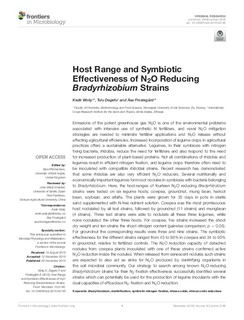| dc.contributor.author | Woliy, Kedir | |
| dc.contributor.author | Degefu, Tulu | |
| dc.contributor.author | Frostegård, Åsa | |
| dc.date.accessioned | 2020-01-03T13:13:16Z | |
| dc.date.available | 2020-01-03T13:13:16Z | |
| dc.date.created | 2019-12-11T13:48:54Z | |
| dc.date.issued | 2019 | |
| dc.identifier.citation | Frontiers in Microbiology, 2019 | nb_NO |
| dc.identifier.issn | 1664-302X | |
| dc.identifier.uri | http://hdl.handle.net/11250/2634829 | |
| dc.description.abstract | Emissions of the potent greenhouse gas N2O is one of the environmental problems associated with intensive use of synthetic N fertilizers, and novel N2O mitigation strategies are needed to minimize fertilizer applications and N2O release without affecting agricultural efficiencies. Increased incorporation of legume crops in agricultural practices offers a sustainable alternative. Legumes, in their symbiosis with nitrogen fixing bacteria, rhizobia, reduce the need for fertilizers and also respond to the need for increased production of plant-based proteins. Not all combinations of rhizobia and legumes result in efficient nitrogen fixation, and legume crops therefore often need to be inoculated with compatible rhizobial strains. Recent research has demonstrated that some rhizobia are also very efficient N2O reducers. Several nutritionally and economically important legumes form root nodules in symbiosis with bacteria belonging to Bradyrhizobium. Here, the host-ranges of fourteen N2O reducing Bradyrhizobium strains were tested on six legume hosts; cowpea, groundnut, mung bean, haricot bean, soybean and alfalfa. The plants were grown for 35 days in pots in sterile sand supplemented with N-free nutrient solution. Cowpea was the most promiscuous host nodulated by all test strains, followed by groundnut (11 strains) and mungbean (4 strains). Three test strains were able to nodulate all these three legumes, while none nodulated the other three hosts. For cowpea, five strains increased the shoot dry weight and ten strains the shoot nitrogen content (pairwise comparison; p<0.05). For groundnut the corresponding results were three and nine strains. The symbiotic effectiveness for the different strains ranged from 45% to 98% in cowpea and 34% to 95% in groundnut, relative to fertilized controls. The N2O reduction capacity of detached nodules from cowpea plants inoculated with one of these strains confirmed active N2O reduction inside the nodules. When released from senescent nodules such strains are expected to also act as sinks for N2O produced by denitrifying organisms in the soil microbial community. Our strategy to search among known N2O-reducing Bradyrhizobium strains for their N2-fixation effectiveness successfully identified several strains which can potentially be used for the production of legume inoculants with the dual capacities of efficacious N2-fixation and N2O reduction. | nb_NO |
| dc.language.iso | eng | nb_NO |
| dc.rights | Attribution-NonCommercial-NoDerivatives 4.0 Internasjonal | * |
| dc.rights.uri | http://creativecommons.org/licenses/by-nc-nd/4.0/deed.no | * |
| dc.title | Host Range and Symbiotic Effectiveness of N2O Reducing Bradyrhizobium Strains | nb_NO |
| dc.type | Journal article | nb_NO |
| dc.type | Peer reviewed | nb_NO |
| dc.description.version | publishedVersion | nb_NO |
| dc.source.volume | 10 | nb_NO |
| dc.source.journal | Frontiers in Microbiology | nb_NO |
| dc.identifier.doi | 10.3389/fmicb.2019.02746 | |
| dc.identifier.cristin | 1759333 | |
| cristin.unitcode | 192,12,0,0 | |
| cristin.unitname | Kjemi, bioteknologi og matvitenskap | |
| cristin.ispublished | true | |
| cristin.fulltext | original | |
| cristin.qualitycode | 2 | |

